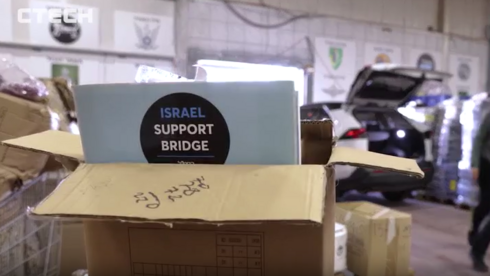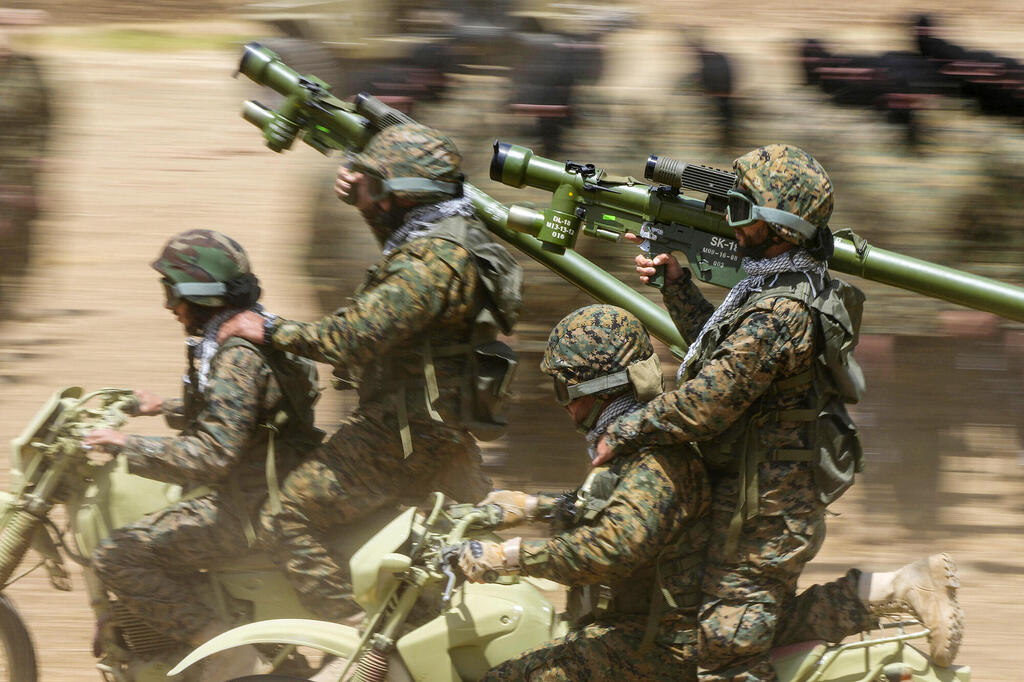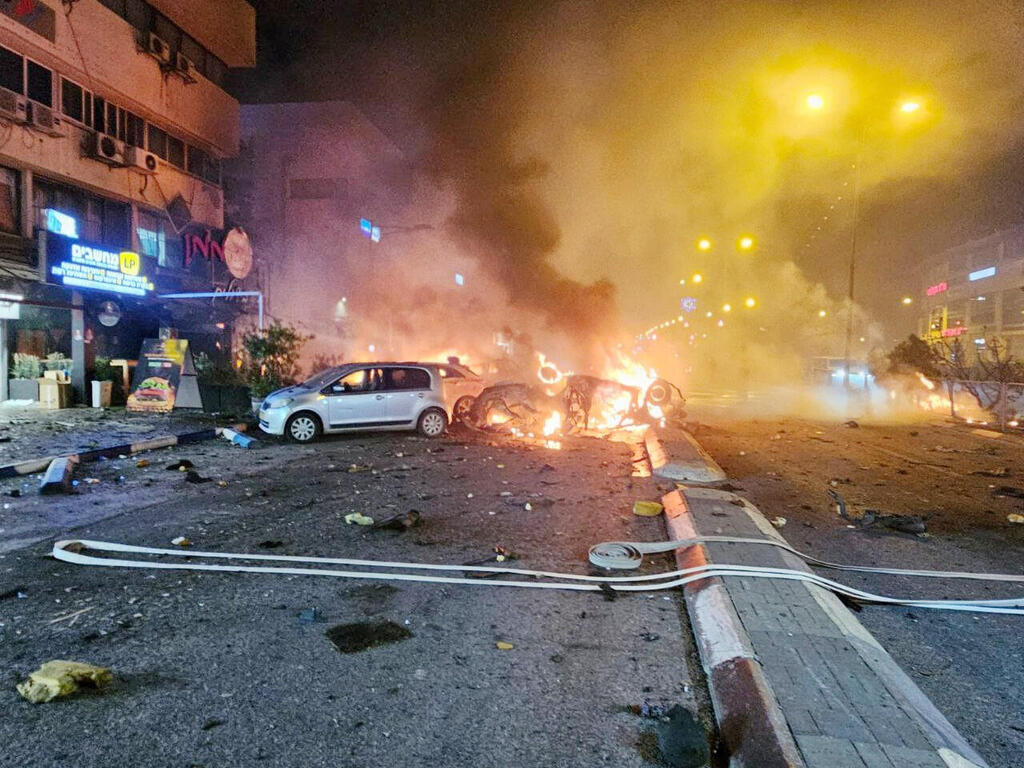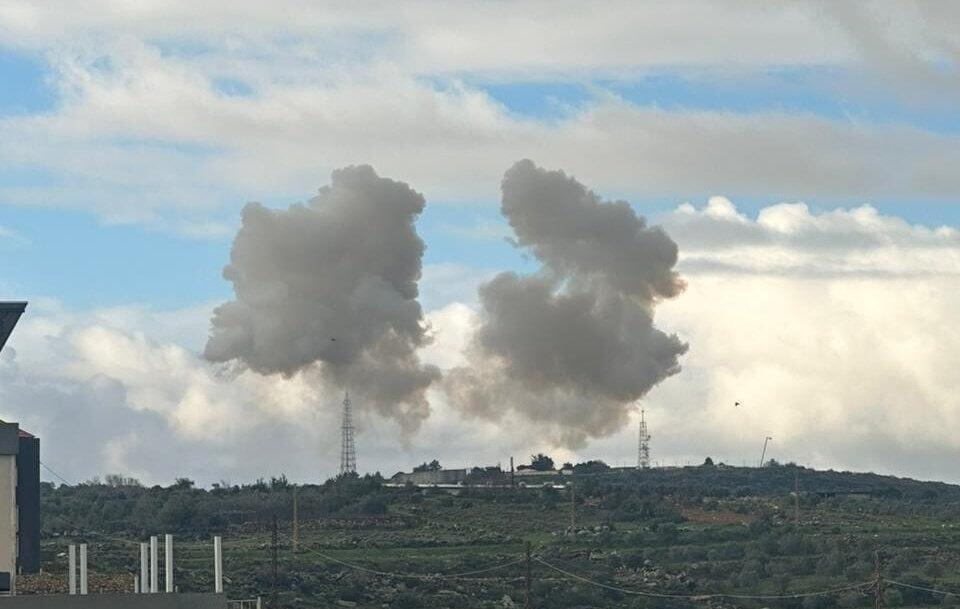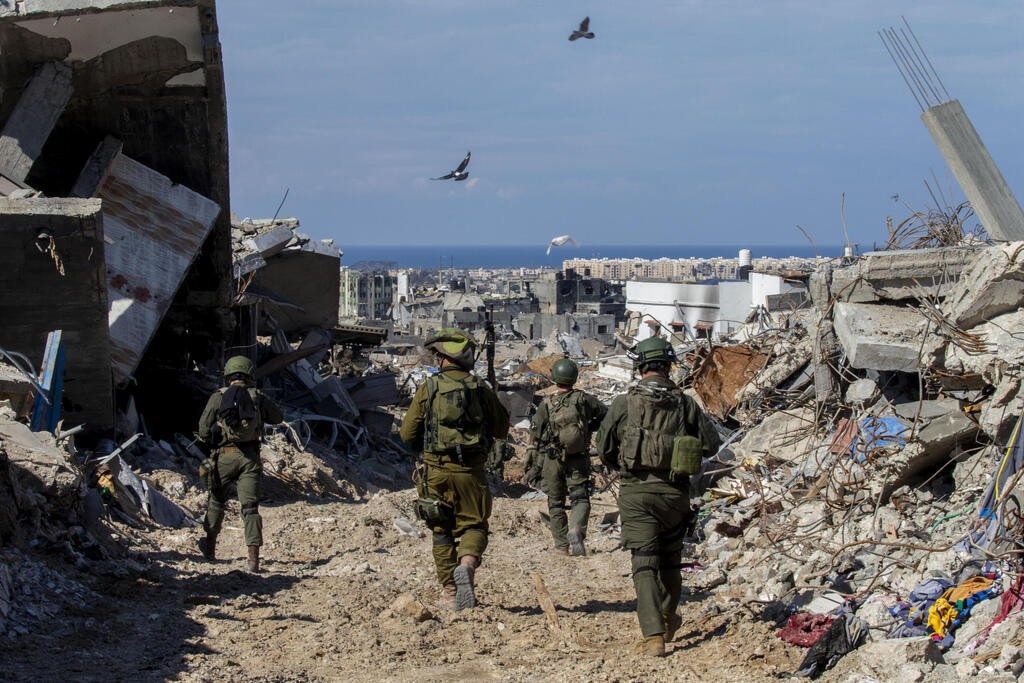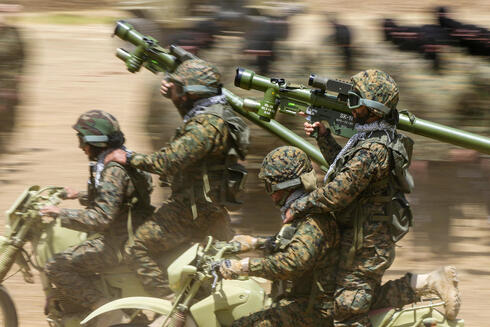
‘Fire and blood’: The chilling reality facing Israel in a war with Hezbollah
Over 100 senior military and government officials participated in a report by Reichman University’s Institute for Counter-Terrorism which details how unprepared the Israeli home front is for an all-out war with Hezbollah
Israel’s war from the north will begin with a massive and destructive barrage of Hezbollah rockets nearly all across the country. The rocket fire will be intense, ranging from 2,500 to 3,000 launches per day, including less accurate rockets and precise long-range missiles. Periodically, Hezbollah will concentrate its efforts, launching massive barrages towards a single target area: a major IDF base or a city in the densely populated center of the country, which will be subjected to hundreds of daily rockets. The barrage will continue day after day until the end of the war, likely three weeks after its outbreak.
In the early stages of the conflict, terror organizations, all Iranian proxies, from across the region will join Hezbollah - Pro-Iranian militias in Syria and Iraq, Hamas and Islamic Jihad in Gaza, the Houthis in Yemen. Beyond causing immense destruction in Israel, including thousands of casualties on both the frontlines and the home front, causing public panic, a central objective of the multi-front attack will be to collapse the IDF's air defense systems. Precision-guided munitions and low-signature weapons, such as loitering munitions, drones, and standoff missiles, will attempt to physically strike and destroy Iron Dome batteries.
The rate of fire will challenge Israeli technology like never before. The stockpiles of Iron Dome interceptors and David's Sling missiles will be depleted within a few days of the fighting, leaving Israel exposed to thousands of rockets and missiles without effective active defense. At the same time, Hezbollah will attempt to disrupt the air force and limit its ability to operate from its bases. Heavy and precise missiles will be directed towards takeoff routes at intervals, preventing or hindering their recovery. Indiscriminate fire will be directed towards hangars storing F-16, F-35, and F-15 planes, which make up the bulk of Israel's main air power.
Precise missiles with hundreds of kilograms of explosive warheads, including cruise missiles, will be aimed at critical infrastructure including power plants, electricity infrastructure, and water desalination and transmission facilities. The seaports of Haifa and Ashdod will be paralyzed, impacting international trade. Dozens of Iranian-made suicide drones will fly at very low altitudes towards high-quality targets deep within Israel, directed at weapon factories, IDF emergency warehouses, and hospitals, which will be overwhelmed with casualties beyond what medical teams can handle, far more than even after October 7.
Missile attacks are only one part of the attack; vital transportation infrastructure, communications, government offices, and local authorities' sites will be targets for widespread cyber-attacks, posing a serious threat to the functioning of the economy. Traffic flow will become difficult and hazardous as the traffic light control systems collapse and the raining of missiles everywhere. Chaos will intensify when Hezbollah sends hundreds of Radwan commandos to seize towns and villages, and IDF posts along the Lebanese border. The IDF will have to fight within Israeli territory, diverting efforts from operations on the ground in Lebanon to take control of launch areas.
On the home front, the public will struggle to receive timely and reliable information about the situation, and lose trust in official sources and spokespeople. Anxiety and panic will mount with the large number of casualties, massive damage, power and water supply disruptions, delays in rescue and relief forces to destruction zones, and difficulties in accessing essential services such as food and medicine. Public anxiety and confusion will be exacerbated by Hezbollah's relentless psychological warfare, flooding mainstream and social media with a disinformation campaign, deepening internal divisions. Those seeking refuge abroad will find that all flights have been canceled.
Throughout the conflict, Hezbollah will start fires in every possible arena, through incitement, encouragement of an uprising in the West Bank and among Israel's Arab citizens, to stretch as many military and police forces as possible to maintain public order. After about three weeks of fire and blood, the unprecedented scale of damage in Lebanon and Israel will lead to the end of the conflict in a stalemate, amid pressure from the international community. Even in the final hours of the war, Hezbollah will continue to rain down missiles and rockets on the home front, according to a systematic plan, while activating launchers from deep within Lebanese territory prepared in advance.
The report: 100 signatories, three years, 130 pages
This horrifying scenario was not written in the wake of Hamas’ October 7th attack on Israel. It is the result of an unprecedented three-year study at the International Institute for Counter-Terrorism at Reichman University, entitled "Dealing with the challenges of the battlefield and winning the war."
The 130-page report is the work of six think tanks made up of over 100 terrorism experts, former senior security officials, academics, and government officials who examined critical aspects related to the level of preparedness for the IDF and the home front in the event of a multi-front war. Signatories to the report, revealed here for the first time, include two generals, former head of the Israeli Military Intelligence Directorate (Aman), Major General Aharon Ze'evi-Farkash and Major General Yitzhak Brik; two former heads of the National Emergency Management Authority, Brigadier Generals Zeev Zuk Ram and Bezelal Treiber; former commander and Israel Prison Service Commissioner, Lt. General Orit Adato; former Home Front Commander of the Northern Front, Brigadier General Eran Makov; former head of the Mossad’s Intelligence Division Haim Tomer; and former Minister of Justice Dan Meridor.
Leading the research is Professor Boaz Ganor, a world-renowned counter-terrorism expert, who founded the Institute for Counter-Terrorism at Reichman nearly thirty years ago and was appointed its fourth president last September. In the months leading up to October 7, he presented his research to relevant military and political authorities in an attempt to rouse intelligence and decision-makers from complacency and misconceptions, albeit unsuccessfully.
Ganor says that due to his understanding of the severity of a multi-front war, he felt a small sense of relief on October 7 that the attack came from Gaza and not Lebanon. "We were in our bomb shelter in Herzliya when the rockets started firing towards the center," he recalls, "My wife told me it was from Gaza. I remember replying to her that if that's the case, it's not so terrible."
3,000 rockets in one morning isn’t so terrible?
"It's a lot, but it was on the first day of the war, and the number of rockets decreased after. In a war with Hezbollah it would continue unabated - numbers of rockets we have never experienced. They have an arsenal that consists of about 150,000 rockets and missiles, and our working assumption is that they would launch about 3,000 at us each day of the war, which according to our estimates, would last about 21 days. And don't get me wrong, it's not that we won't win such a war; Israel is much stronger than Hezbollah, certainly stronger than Hamas."
It's good that you clarified that, because anyone reading the scenario presented in your report might get the terrifying impression that defeat is imminent.
"We won't be defeated. Our scenario - which is far more severe than what happened on October 7th - is certainly not an existential war for Israel. Such a war would cause us strategic damage, but Israel would not give up and not know how to cope. By the way, the Gaza war is also not an existential war - not even on October 7th."
This wasn’t the message the Israeli public received in the early days of the war.
"Correct, and I was really horrified to hear people saying things that were just not true. The first is that Israel is in an existential war - it’s far from being an existential war, but you also can't tell the public, shocked by the terrible massacre, that we're in an existential war. What kind of message is that? The second message was that we are in the ‘Second War of Independence,’ and that's nonsense too. On October 7th, we weren’t in a ‘War of Independence’ and still aren’t. It's a statement that creates unnecessary panic."
That was the rhetoric of the Prime Minister.
"I don't want to blame anyone specifically. I heard it from several people, and whoever did spoke foolishly when the public was in collective shock."
Misconceptions won’t prevent rockets
The six think tanks that drafted the report examined various threats and preparedness for them: a complete collapse of the Palestinian Authority, leading to widespread violence in the West Bank; incitement and encouragement by Hezbollah of extremists from within Israel's Arab population to block traffic routes and thus hinder the arrival of forces to the front; riots in the mixed cities; difficulty in conveying the challenges of the war to the public and low expectations of the IDF and rescue forces; preparation of local authorities for their critical role in providing assistance to citizens in distress, from rescuing and evacuating the wounded to providing first aid.
The think tanks also examined what an Israeli preemptive attack would look like, and it is the only part of the report whose details are banned from publication.
The report maps out operational gaps, pointing out both military and societal weaknesses, and includes immediate actionable recommendations. The report was completed months before the Hamas attack, and one of its most disturbing conclusions concerns the Israeli public, which is simply unaware that it will be required to cope with the initial days of heavy fire alone.
"The expectation of the public and of a significant portion of the leadership, that the Israeli Air Force and effective Israeli intelligence systems will succeed in preventing most of the rocket attacks on Israel, will be shattered. This is also the case regarding the public’s belief that the threat of Israeli retaliation or a substantial Israeli attack on significant Lebanese assets will force Hezbollah to cease fire or significantly impair their ability to continue attacking Israeli territory," said the report.
This assessment is based on the accuracy and intensity of Hezbollah’s missiles, which will quickly deplete the IDF's interceptor arsenal, and the difficulty of the Air Force in disabling rocket launch systems, which will be dispersed and camouflaged over a vast area, not only in Lebanon but also in Syria and possibly Iraq.
The report pays special attention to IDF ground forces and their ground maneuvering capabilities in multiple and simultaneous theaters of war. When they begin to maneuver, ground forces will encounter dense Hezbollah defense systems, well-armed and ready for combat, and many anti-tank teams. Even in an optimal situation where armor columns and infantry forces penetrate deep into Lebanon to take control of launch areas, the maneuver may prove to be irrelevant. The heavy fire on the home front will continue because Hezbollah can conduct distributed combat operations from many areas, which are capable of acting independently.
One of the main conclusions is that in a war based on doctrines and conventions from the previous century, the IDF could suffer losses, and Israel's weakened position could make it difficult to reach a cease fire.
What was the data that you based your scenario on?
"In most cases, open information provided by Hezbollah. Anyone following the organization could find it. We didn’t uncover new information, just listened and studied what was out there, nothing beyond that. For example, we have a Hezbollah video that shows in detail what they intend to do on the day they launch a ground invasion of Israel’s northern towns."
It’s likely that IDF intelligence is aware of this and knows Hezbollah's capabilities.
"Yes, but these things were understood in intelligence as propaganda, and it turns out that the information about Hamas was understood in the same way. On the other hand, we took what Hezbollah says and does seriously, examining intentions versus capabilities, without referring to intelligence analysis."
Such as?
"We took things at face value, without hypothesizing that Hezbollah or Hamas publish things they don't truly intend to do."
Your war scenario includes a Hezbollah ground invasion of settlements in the Galilee, which happened on October 7th in the south. This is a fairly accurate copy of a Hezbollah plan which has been known for years.
"And, not by chance. The current operation is Iranian-led, a move designed to achieve several objectives, including revenge for at least ten years of back and forths with Israel. The Iranians have patience, time, and intelligence, and they got their revenge. Including, ending normalization between Israel and Saudi Arabia. From Iran's perspective, there is no greater strategic threat than such normalization, which would establish the basis for a regional military alliance against it. Therefore, from its perspective, it was the perfect time to do it. The southern raid and slaughter is exactly Hezbollah's plan in the north. Hamas received the plan from Iran and Hezbollah, who guided and armed Hamas, and set the date."
Why did the Iranians choose Hamas to execute this plan?
"Because they knew that if they implemented their plan through Hezbollah, the scope of the damage to Israel would be several times greater than by Hamas. They assumed it would lead Israel to a disproportionate, maybe even irrational, response, and they wanted to retain control. Hezbollah is an Iranian strategic asset intended to deter Israel and the U.S. from attacking its nuclear facilities, and it wouldn’t have made sense for them to waste this asset at that point. It was better to use their weaker military arm."
Hezbollah and Iran themselves claim that they were surprised by Hamas's attack, and that Sinwar kept them in the dark.
"This is a lie, and it was planned with all the other players, so everyone could claim that they didn't know. I've seen information from open sources about meetings that took place a week before the attack in Beirut between senior Hamas, Hezbollah, and Iranian officials. The Iranian denial supposedly strengthens Hamas, which proudly claims it carried out the attack alone."
And by doing so, they really torpedoed Israel's normalization with Saudi Arabia.
"Maybe temporarily. It's not certain it will last for long."
Leadership must cultivate public resilience
The report has not yet been exposed to the public, but Ganor says he presented it to a long list of military officials and decision-makers: "Several months before the war, I presented the report to all of the state’s leaders, over the course of about forty meetings. Former Prime Minister Naftali Bennett, Defense Minister Yoav Gallant, former National Security Advisor Eyal Hulata, Head of the Military Intelligence Directorate (Aman) Aharon Haliva, former IDF Chief of Staff Aviv Kochavi, and more."
Did Prime Minister Netanyahu see your report?
"He received it, but did not meet with us, and neither did the head of the National Security Council, Tzachi Hanegbi, even though we requested a meeting."
Were you disappointed or surprised?
"Both. Overall, this document is signed by a very impressive list of people, and it would have been right for them to meet and hear more in person. I'm not disappointed in cases where people met with us, but chose not to accept the thesis we presented because the security establishment was imprisoned by “the concept.” But, I do blame those who didn’t even meet with us."
Did you meet with Gallant or IDF Chief of Staff Herzi Halevi?
"We met with Gallant. I don't know how troubled he was by the gaps that emerged from the report, compared to the IDF's stance, but he definitely instructed his staff to try to understand where they came from. Former IDF Chief of Staff Aviv Kochavi met with us for four and a half hours. We presented him with the details, and he presented his opposing view, which I prefer not to elaborate on. The report also reached IDF Chief of Staff Halevi, but we didn't manage to meet because the war broke out."
What are these gaps you're referring to?
"Our scenario was more severe than the IDF’s. There wasn't a big difference in terms of the number of rockets that would be fired at us, but our assessment included many more casualties and greater damage to the economy. The IDF’s scenario assumed that the state systems would know how to maintain the functioning of the economy, with the cornerstone of this assumption being that the local authorities would take matters into their own hands. We believe that the national systems are imposing responsibility on the local ones, thus absolving themselves of it. When we studied the issue with the local authorities, it was clear that they expected the national systems to take over in a major crisis. A situation has emerged in which each system puts its trust in the other. We believe that, given the extent of the damage that will occur, the national systems will find it very difficult to meet the expectations of local authorities."
What is the significance of public resilience in such an extreme situation?
"One of our main problems in discussions with the IDF was the resilience of the public, so one of our central messages was the need to prepare and educate the public about the threat of a multi-front war. The public needs to understand the implications and prepare for them, including by establishing neighborhood emergency units of volunteers. Israeli society needs to be re-mobilized."
Were you able to convince anyone?
"The Home Front Command and the decision-makers in the army thought there was no need, that it would create unnecessary panic, and that it's better to educate the public to gradually cope with emergency situations like tsunamis, earthquakes, or war. We believed that the psychological effect of war is one that should be prepared for at the individual, family and community level - but we weren’t able to convince anyone."
Weeks before the outbreak of war in the south, Ganor and his fellow researchers presented the report to an IDF general whose name he prefers not to disclose. "After this meeting," he says, "I was more worried than before."
What happened?
"The meeting was held at the request of the political echelon. I was accompanied by Major Generals Gershon Hacohen and Brik, and Brigadier General Zuk Ram. We presented the report for about an hour and a half, and then the general turned to one of his department heads - an officer who apparently had confidence in the IDF scenario - and asked him to explain the difference between the scenarios. The officer replied that he couldn’t because the IDF scenario is based on intelligence and he doesn’t know what ours is based on. I went home shaken. My wife asked me how it went, and I answered her in two words: Yom Kippur."
Why "Yom Kippur"?
"Because I understood that we weren’t dealing here with one ‘concept,’ but with a combination of concepts - exactly the same ones from the Yom Kippur war, fifty years ago. A report like ours should have served as a warning for the system, to be checked against the concepts at least."
Which mistaken concepts are we talking about?
"For example, one argues that Hamas cannot carry out an operation of this magnitude, just as we believed on Yom Kippur that the line of fortifications along the Suez Canal was impenetrable until the Egyptians breached the sand barriers with water cannons. There were not enough forces in the area on October 7th because of operational misconceptions. There was another problem with regard to the preparedness of the few units that were in the area that morning and did not enter their positions immediately."
We can take comfort in the fact that the Gaza war at least removed the sting from Hezbollah's plan in the north.
"Today our situation is different from what it was on October 6th, mainly because we cannot be surprised by a ground invasion. But Hezbollah's missile stockpile is still there, and at the moment, the response to this threat is primarily Hezbollah's knowledge that whatever damage it manages to do to us will be ten times worse in Lebanon. One of the reasons that the organization has not engaged in a large-scale war with Israel - but may do so later - is that it is clear to them what the consequences of Israel's response will be. A mutual deterrence has been created, expressed in a very limited war."
How does the level of cruelty of Hezbollah's Radwan forces compare to Hamas?
"The immediate answer is that there is no difference. They are the same; they have no limits. And, if God forbid the ground operation had taken place in the north, we would have seen the same patterns and the same cruelty we saw in the Gaza periphery, just on a much larger scale. But there is another element that I have researched extensively in the past, and that is the Captagon drug, which since 2006 has become an industry that Hezbollah profits greatly from. It was used on October 7th, and whoever takes it goes completely mad, very alert for days, with zero inhibitions. Not that these people have many inhibitions, but if they do, the drug removes them.”
The recommendation: a larger and stronger army
The report did not just point out risks but added practical proposals to improve the readiness of the IDF and the Home Front for war. In their view, a real revolution is required in the IDF's ground forces, as the capabilities and combat methods to which it has adhered over the years will not provide an answer to the new threats in warfare. This includes the need to deal with the changes on the battlefield, especially the focus on fighting in built-up areas and underground formations that the army faced during the war in Gaza.
Beyond that, the report indicates that much larger forces than anything we have known will be needed; more soldiers, tanks, armored personnel carriers, and the development of a combination of capabilities that will enable fighters to operate in each of the unique arenas. This growth will be a condition for the operational flexibility of forces in the field — even if it undermines the long-held aspiration for a smaller and smarter army. The IDF will need to become large and resource-rich, with weapons and technology.
But it's not just about size. The report recommends reviving a plan from the past and establishing a missile corps, which will utilize an advanced command and control system to shorten the time from the detection of emerging threats in the field to their destruction. The missile corps will be able to respond faster than the Air Force's fighter jets and UAVs, be just as accurate and deadly, and even if the bases are hit, the missiles will allow for precise fire up to a range of 400 km. This would be costly: about $3 billion spread over five years. According to the report, "Given the threats... the necessary resources must be immediately allocated to implement a defensive-offensive option of counter-fire using the missile corps."
In addition to building an effective missile system, one of the central recommendations concerns the laser defense system, Iron Beam, which is in advanced development by defense company Rafael. Ganor sees it as "the only solution that can provide a significant response to the threat of missiles and rockets aimed at the home front." They recommend making its development a top and urgent priority, accelerating processes, removing bureaucratic barriers, and allocating all necessary resources.
Faced with the threat of suicide drones and cruise missiles, the report recommend deploying an array of radar-controlled anti-aircraft guns, which will provide effective protection at relatively low cost compared to the enormous potential damage that would occur without them. Today, such cannons are not part of Israel's air defense system, which is considered the best in the world, but is entirely based on expensive missiles and not designed to engage a large number of targets simultaneously and at low altitude.
Even after implementing these recommendations, there must be a drastic improvement in the passive defense infrastructures on the home front, including the responsibility to shelter and close gaps in residential, office, and industrial structures, while preparing large underground parking lots and transportation tunnels, such as the Carmel Tunnels, to provide shelter for thousands for an extended period.
One section of the report deals with the organizational culture of the IDF, "which we found to have problems," says Ganor. The report recommends the appointment of a new deputy to the Chief of Staff, responsible for the organizational culture.
What are the problems with the organizational culture?
"Lack of professionalism in conducting investigations, perhaps due to turning a blind eye or lack of attention, which leads to inaccurate reporting upwards and an attempt to align with the commander's opinion. This affects the readiness of the IDF and its ability to improve, and the recommendation is to solve the problem through a functionary, a deputy to the Chief of Staff, appointed by him, responsible for long-term processes: training plans for soldiers and commanders, force building, development of means and methods of combat, budgetary control, and more. This will be a reservist officer who isn’t a candidate for the position of Chief of Staff and will serve for at least five years, even if the Chief of Staff changes."
Could such a function have ensured that someone would listen to the warnings of the field observers on the Gaza border?
"For example."
Gaza will continue to be a problem
Ganor, 62, began his tenure as president of Reichman University only two weeks before the war. "After being elected to the position, I went to Prof. Uriel Reichman, laid the report on his desk, and told him that I was very disturbed by the state of the country in total war, and that such a war has implications for Reichman University, and we need to prepare for it."
What does that mean?
"That we, unlike endowed universities, need to prepare differently, and this was proven in the insane challenge that arose. I turned to veteran donors and managed to open the academic year two weeks earlier than the rest, with an unprecedented plan for students in the reserves. Every reservist has a mandatory package, including private tutoring, and extra lessons during vacation."
Ganor says that the slaughter in the south and the war shook his approach to resolving the conflict. "The problem is the day after the IDF leaves Gaza. It's a matter of time until the population supporting Hamas grows again; one year, five, or seven years - eventually it will happen. Even if tomorrow we succeed in destroying most or all of Hamas's military capabilities and neutralizing Yahya Sinwar, there are still at least another million and a half Palestinians in the Strip who support it and will grow the next leaders. Some think that the solution is settling in Gaza or transferring its residents. But both of these are unrealistic."
So the issue of Gaza is a foregone conclusion?
"Until a political solution is reached - and there doesn’t appear to be one on the horizon. The Palestinians shot Israel in the foot, but they shot themselves in the heart because they pushed the two-state solution away for a generation. Even those who supported this alternative, including me, understand that in the foreseeable future, it will not be on the table. A solution always involves risk, and for years I thought that Israel was capable of taking it. After October 7th, I think the risk is too great. Israel needs to prepare differently, build a different army and capabilities so that it can reach a diplomatic solution in the future and take such a risk."








